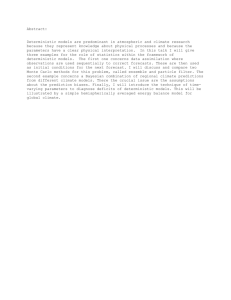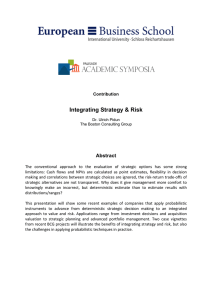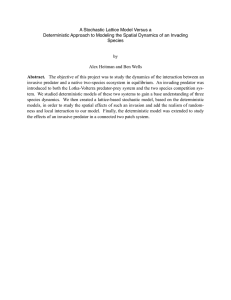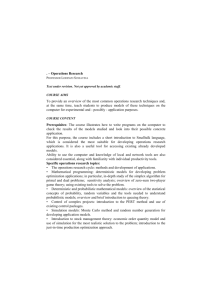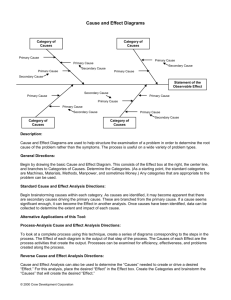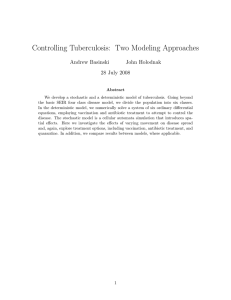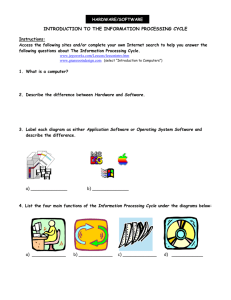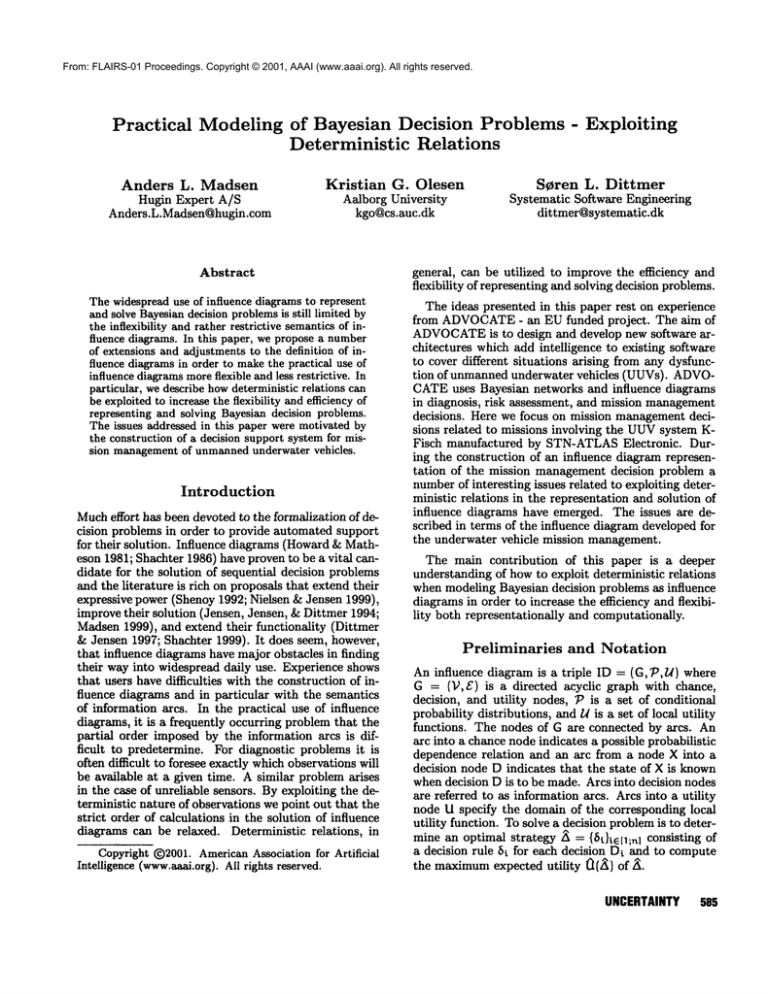
From: FLAIRS-01 Proceedings. Copyright © 2001, AAAI (www.aaai.org). All rights reserved.
Practical
Modeling of Bayesian Decision Problems - Exploiting
Deterministic Relations
Anders
L. Madsen
Hugin Expert A/S
Anders.L.Madsen@hugin.com
Kristian
G. Olesen
Aalborg University
kgo@cs.auc.dk
Abstract
The widespread use of influence diagrams to represent
and solve Bayesiandecision problemsis still limited by
the inflexibility and rather restrictive semanticsof influence diagrams. In this paper, we propose a number
of extensions and adjustmentsto the definition of influence diagrams in order to makethe practical use of
influence diagramsmoreflexible and less restrictive. In
particular, we describe howdeterministic relations can
be exploited to increase the flexibility and efficiency of
representing and solving Bayesian decision problems.
The issues addressed in this paper were motivated by
the construction of a decision support system for mission managementof unmannedunderwater vehicles.
Introduction
Mucheffort has been devoted to the formalization of decision problems in order to provide automated support
for their solution. Influence diagrams (Howard& Matheson 1981; Shachter 1986) have proven to be a vital candidate for the solution of sequential decision problems
and the literature is rich on proposals that extend their
expressive power (Shenoy 1992; Nielsen & Jensen 1999),
improve their solution (Jensen, Jensen, & Dittmer 1994;
Madsen 1999), and extend their functionality (Dittmer
& Jensen 1997; Shachter 1999). It does seem, however,
that influence diagrams have major obstacles in finding
their way into widespread daily use. Experience shows
that users have difficulties with the construction of influence diagrams and in particular with the semantics
of information arcs. In the practical use of influence
diagrams, it is a frequently occurring problem that the
partial order imposed by the information arcs is difficult to predetermine. For diagnostic problems it is
often difficult to foresee exactly which observations will
be available at a given time. A similar problem arises
in the case of unreliable sensors. By exploiting the deterministic nature of observations we point out that the
strict order of calculations in the solution of influence
diagrams can be relaxed. Deterministic relations, in
Copyright (~)2001. AmericanAssociation for Artificial
Intelligence (www.aaai.org).All rights reserved.
Scren
L. Dittmer
Systematic Software Engineering
dittmer~systematic.dk
general, can be utilized to improve the efficiency and
flexibility of representing and solving decision problems.
The ideas presented in this paper rest on experience
from ADVOCATE
- an EU funded project. The aim of
ADVOCATE
is to design and develop new software architectures which add intelligence to existing software
to cover different situations arising from any dysfunction of unmanned underwater vehicles (UUVs). ADVOCATEuses Bayesian networks and influence diagrams
in diagnosis, risk assessment, and mission management
decisions. Here we focus on mission managementdecisions related to missions involving the UUVsystem KFisch manufactured by STN-ATLASElectronic.
During the construction of an influence diagram representation of the mission managementdecision problem a
numberof interesting issues related to exploiting deterministic relations in the representation and solution of
influence diagrams have emerged. The issues are described in terms of the influence diagram developed for
the underwater vehicle mission management.
The main contribution
of this paper is a deeper
understanding of how to exploit deterministic relations
when modeling Bayesian decision problems as influence
diagrams in order to increase the efficiency and flexibility both representationally and computationally.
Preliminaries
and Notation
An influence diagram is a triple ID = (G, ), U} where
G = (~;,E) is a directed acyclic graph with chance,
decision, and utility nodes, 7) is a set of conditional
probability distributions, and/4 is a set of local utility
functions. The nodes of G are connected by arcs. An
arc into a chance node indicates a possible probabilistic
dependence relation and an arc from a node X into a
decision node D indicates that the state of X is known
when decision D is to be made. Arcs into decision nodes
are referred to as information arcs. Arcs into a utility
node tl specify the domain of the corresponding local
utility function. To solve a decision problemis to determine an optimal strategy ~ = {Si}ie[lml consisting of
a decision rule 5i for each decision Di and to compute
the maximum
expected utility {](z~} of z~.
UNCERTAINTY 58S
Let 7~ = {R1,..., R~} and D = {D1 .... , Dn} denote
the chance and decision variables, respectively. Furthermore, let ~ = {P{R1I pa(R1 )) .... , P(Rm[pa{Rm))}
and/4 = {U1.... , Uo}be sets of probability distributions and local utility functions, respectively. From
and U, l:l(/~} can be computedas:
(1)
where Mis the generalized marginalization operator
introduced by (Jensen, Jensen, & Dittmer 1994).
The set of chance variables T~ is partitioned into disjoint information sets Z0,..., Za relative to the decision variables. The partition induces a partial ordering -~ on the variables of the decision problem. The
set of variables Z~ observed between decisions D~ and
Di+l precedes Di+l and succeeds Dt in the ordering:
27o -~ D1-~ Z1 ... -~ DrL -~ Zn. Wewill for ease of exposition assume a total order on the decision variables.
Equation 1 can be computed using local computation
by iteratively eliminating variables one at a time. Let Y
be the next variable to eliminate and let (gy = {qb E (9
Y E dora(~)} and ~gy = {~ E lg [ y E dom(~)} where
(9 and lg are the current sets of probability and utility
potentials, respectively. Calculate ~} = MyI-Ieecy
and ~ = My l’-I,~eey
¢ )’-*e~’r
~b and update the sets
f q,*1
logical ¢ommunlationbun (ORB)
Figure 1: The CORBA
architecture.
ing energy will occur. At this point a decision on the
further continuation of the mission has to be made by
the mission management. An influence diagram model
has been developed to support this decision. In order
to support mission managementdecisions on the continuation of a mission is it necessary to represent the
planned mission in the influence diagram. A decision
on the continuation of the mission is based on the remaining energy and the estimated energy consumption
of the underwater vehicle. The decision is either to proceed with the mission as planned, to abort the mission,
or to decrease or increase the speed of the vehicle. A
rough sketch of the model is shownin figure 2.
(9and
¯ as(9"=(gu(¢V}\(gy
An elimination order a is a legal elimination order, if
all variables in information set Zi are eliminated before
Di for all i. Thus, Zo is the set of variables initially observed and Za is the set of variables never be observed
or observed after the last decision has been made. A
legal elimination order can be organized as a strong
junction tree (Jensen, Jensen, & Dittmer 1994).
An observation on a variable R implies that the exact
state r of R is knownand is entered as an instantiation
potential. A instantiation potential f{R) is a deterministic function with domain R taking on the value 1 for
the state r and 0 otherwise.
The
ADVOCATE
Project
ADVOCATE
describes a distributed system for diagnosis and control of UUVs. The ADVOCATE
system consists of a number of modules which communicate via a
logical bus based on the CORBA
standard, see figure 1.
In this paper we focus on the mission managementproblem which involves monitoring the energy consumption
in an autonomous underwater vehicle (AUV) and consequently the decisions on the further continuation of
the mission.
The assumption is that at some point during operation of the AUVan unexpected reduction in the remain586
FLAIRS-2001
Figure 2: A rough sketch of the ADVOCATE
model.
The influence diagram model was extracted from domain experts describing the physical relations between
the components of the AUV,in particular the power
supply. The uncertain relations stem from the uncertain measurements of the remaining energy and the exact discharge characteristics of the powersupply as well
as the expected energy consumption.
Uncertain
Information
Arcs
The information arcs of an influence diagram indicate
the order in which information becomesavailable to the
decision maker. During the construction of an influence
diagram representation of a Bayesian decision problem,
the model builder asks the domain expert to specify
the order in which information becomesavailable. This
may, however, not always be possible. For instance,
a domain expert may want to specify that either she
has made an observation on a particular variable R before the first decision, R will never observed, or R will
be observed after the last decision has been made. In
this case the set of variables initially observed (20)
not knownuntil the decision maker has specified which
variables are observed. If the solution of an influence
diagram is postponed until 270 and the states of the
variables of 270 are known, then the computational efficiency can be improved w.r.t, both space and time.
Usually, the variables of 770 are the last variables to be
eliminated when solving an influence diagram ID, but
since the solution of ID is postponed until 270 and the
states of the variables of 270 are known,the variables of
770 can in fact be eliminated at any point.
The computational saving is caused by a reduction in
the size of the effective junction trees. Aneffective junction tree is the junction tree used to perform the computations and not the junction tree constructed from the
influence diagram representation of the problem. We
propose to extend the definition of influence diagrams
to include a notation - a dashed arc - specifying that
a variable R either is observed prior to the first decision, after the last decision, or not at all. These arcs
will be referred to as uncertain information arcs. The
proposed extension can simplify the modeling task considerably as it facilitates the representation of different
decision scenarios within the same influence diagram.
Example 1
Consider a decision problem involving an uncertain entity A which the decision maker may have two observations F1 and F2 on. This produces 4 different information scenarios, see figure 3. If F1 and F2 are known
prior to the first decision D, then:
0(~) ~-mDa
x ~’- P(A)P(FIIA)P(F2IA)U(A,D).
F1 ,Fz
A
Figure 3: Observations on F1 and F2 are possible.
The deterministic relations induced by the instantiation potentials on F1 and F2 can be exploited to reduce
the computational complexity of computing I:1(/~):
junction tree structure for a set of different decision
scenarios. Due to the deterministic nature of instantiations, the variables of 270 can in fact be eliminated at
any point during the solution of the influence diagram.
Proposition 1. A deterministic potential f(X} on a
variable X E 270 implies that X can be eliminated at any
point.
The fact that observed variables of 270 in decision
problems with a single decision can be eliminated at
any point has been used extensively when representing
and solving influence diagrams. Corollary 2 shows that
this property holds in general.
Corollary 2. Observed variables of 27o can be eliminated at any point.
Eliminating an instantiated chance variable R E 270
before decision variable D1 may produce decision rules
with too large domains. That is, the domain of a decision rule 5t (dora(fit}) for decision variable Dt
contain variables which are irrelevant for Dr. However,
it is possible through a structural analysis to determine
whether all variables of dora(St) are relevant for Dr,
see e.g. (Nielsen & Jensen 1999). This can also be determined through a numerical analysis of 5t.
Mission
and
Background
Information
For the task of mission replanning it is necessary to
represent information about the planned mission in the
model. A planned mission is represented by the distance to cover (Dp) and the speed to cover the distance
with (Sp). From Dp and Sp the time planned for the
mission -I’p is computed. At the point of decision, the
progress of the mission (M) is known. This is used
to compute the remaining distance (DR) and the time
used so far (Tu), see figure 4(a).
At the point of decision (D) information about the
planned mission such as the planned speed (Sp), the
progress of the mission (M), the remaining energy
(RM), and the planned distance to cover (Dp) may
known,see figure 4(b).
0(,~} =mDax~--" P(A)U(A, ~-" P(F11A)f(F1)
A
F1
~’- P(F2IA)f(F:z).
F2
The difference in computational complexity of the
above equations is even further emphasized, if the instantiations on F1 and Fz are entered by domain reduction rather than by marginalization.
[]
Eliminating the variables of 270 before any decision
variable is eliminated will reduce the size of the junction tree. b-hrthermore, it is possible to exploit the same
(a)
(b)
Figure 4: Planned mission(a) and the information available to the decision maker(b).
The time to complete the mission Tp is a deterministic function of De and Sp. This implies that 1:1{~)
is independent of whether or not Tp is specified to be
knownby the decision maker before the decision.
UNCERTAINTY 587
In ADVOCATEreadings
on sensorsand datain generalmightbe lost.Thus,it is impossible
forthedomainexperts
to specify
thesetof background
informationvariables.
Thesolution
of thedecision
problem
is
postponed
untilthesetof observed
variables
is known.
Thus,a singlejunction
treecanbe usedto solvethe
decision
problem
fordifferent
decision
scenarios.
Reduction
of Possibilities
In a symmetric Bayesian decision problem the set of
the decision options dom(Di) available to the decision
maker at a decision Di are assumed to be independent
of the past. This is, however, almost never the case
in practice. It is often desirable to reduce the possible
decision options at a decision in the future based on
decisions and observations made in the past. The set
of decision options available to the decision maker can
be constrained by introducing a constraint variable C
with two states ~ and n. The state of C is a deterministic function of its parent variables which returns ~ for
all legal parent configurations and rt otherwise. The
legal configurations are enforced by instantiating C to
!$ before the decision problem is solved.
Example 2
Assumethat we are modeling a single player card game
where the decision maker holds three cards (an ace CA),
a king (K), and a queen (Q)). Assume the decision
maker has to make two decisions. The first card to play
(D1) and the second card to play (D2). Once a card
been played it cannot be played at a later point. Thus,
the decision options at the second decision has to be
constrained such that the same card is not played twice.
This can be achieved by introducing a child constraint
variable CC) of D1 and D2, see figure 5.
If someof the utilities are negative, then constraint
variables can introduce serious problems as expected
utilities might be zero CELl= 0) due to the utility being
zero (U = 0) or due to zero probabilities (p = 0) representing illegal state space configurations. Thus, the use
of constraint variables can imply that a decision option
d for a decision variable Di can have EU(Di = d} =
while EU(Di = d’) < 0 for all d’ ¢ d. This, implies
that maxD~)-’~WD~~ = d, but selecting Di = d will
produce an illegal state space configuration. Furthermore, the introduction of constraint variables makesthe
semantics of the model less clear. Notice that a linear
transformation of the (total) utility function solves the
problemof negative utilities.
Wepropose to model the asymmetry using deterministic functions specifying the legal configurations of decision variables based on the fact that constraint variables correspond to introducing a deterministic function
f{:D’, T~’} where:D’ C_ :D and T~’ C T~. Weare not introducing a new formalism to represent and solve asymmetric decision problems in general. Rather, we are
proposing methods to handle restricted kinds of asymmetry within the framework of symmetric Bayesian decision problems and to solve these problems using existing efficient methods for solving symmetric decision
problems. None of the existing methods for representing and solving asymmetric Bayesian decision problems (e.g. (Shenoy 2000) or CNielsen & Jensen 2000))
are complete in the sense that all asymmetries can be
represented without the introduction of special states
and solved efficiently without some unnecessary computations. Therefore, it is still necessary to develop or
extend the existing frameworkof influence diagrams for
representing symmetric Bayesian decision problems to
cope with asymmetries more efficiently.
Mission
Figure 5: A single card can only be played once.
The influence diagram ID of figure 5 specifies that
the state of C is not knownuntil after both decisions
have been made. This is, however, not the case. In
fact, the state of C is knownprior to the solution of
ID. According to the traditional definition of influence
diagrams the decision maker observes the variables of
2:0 and nothing else before the first decision is made.
However, C ¢ 2:o and C is known before the first decision. Thus, according to the traditional definition of
influence diagrams, IO is not a valid influence diagram
due to the missing arcs from C to D1 and D2. However,
due to the deterministic nature of constraint variables
these arcs are not required.
[]
688
FLAIRS-2001
Termination
Wewant to model the fact that the mission should be
aborted CA), if the mission cannot be completed given
any of the possible speeds (D). That is, the mission
should be aborted if the remaining energy (RM)is less
than the required energy CRQ)to complete the mission
given any speed, see figure 6.
Figure 6: The mission is aborted if there is not enough
energy to cover the distance given any speed.
The variable R specifies whether or not RM< RQ.
The variable L specifies whetheror not the vehicle is lost
during the mission. To ensure the mission is aborted
when RM< RQ, the vehicle is assumed to be lost if the
mission is not aborted. This situation could be modeled
more elegantly, if the possible decision options could be
restricted using a deterministic function over D, RQ,
and RM.
Deterministic
Relations
In general, deterministic relations in influence diagrams
are not only introduced by instantiations of variables
and constraint variables. Deterministic relations can
be specified in the conditional probability distributions
of the model. Deterministic relations can be exploited
to relax the constraints imposed by information arcs on
the possible orders of elimination. Additional degrees
of freedom in the selection of elimination orders can
be exploited to increase the computational efficiency
of solving Bayesian decision problems. A deterministic
child variable X can be eliminated at any point in time
up to the point where all its parent variables are known.
formed before S is known, but especially if the computations are performed after S is known.
[]
Deterministic relations cannot only be exploited to
commute the marginalization of chance and decision
variables, they can also be exploited to distribute the
marginalization of decision variables over local utility
functions.
Example 4
Consider the influence diagram ID depicted in figure ?(b) and assume once again that the relationship
between S and T can be described as a deterministic
function. Exploiting the deterministic relationship between S and T, the maximumexpected utility Q(~)
the optimal strategy ~ is computed as:
)= ~- PCW)~-" PCS)mDax~- P(TIS
Example 3
Consider the influence diagram ID depicted in figure 7(a) and assume the relationship
between S and
T can be described as a deterministic function.
+P{TI S) ~- P(VIT)U{S, V,W}).
(3)
V
(a)
(b)
Figure 7: Twoexamples where the relationship between
S and T is assumed to be deterministic.
Due to the deterministic relation between S and T,
we can compute maximumexpected utility ~1(~) of the
optimal strategy ~ as:
= )-- ~-- p(S) mDax~-- PCTIS)P(VIT)UCT,)
v
S
T
= ~-~-P(S)~-mDaxP(TIS)P(VIT)U(T,D
).
V $
T
That is, the marginalization of D and T can be commuted. Next, assume S = s is known which implies
T -- t and produces:
fl(~}
= ~e(VIt}e(s)P(tls)mDaxU(t,D)
V
=
). ~--P(VIt}P(S)mDaxU(t,D
Thus, the deterministic relationship between S and
T can be exploited both if the computations are per-
Equation 3 does not offer a decrease in the total number of operations performed in order to solve ID compared to equation 2. It can, however, be used to reduce
the number of multiplications and additions by increasing the number of maximizations.
[]
Battery
Model
The estimated energy consumption (RQ) to cover the
remaining distance (DR) given different speeds (SR)
a function of the current (C) drawn from the battery
and the remaining time (TR), see figure 8(a). The speed
SR should be selected such that RM> RQ. In order to
compute RO, it is necessary to represent the battery
in the model. The power (P) drawn from the battery
is computed as a function of SR, the drag factor (DF),
the efficiency of the thrusters (ET), the cross section
(Cs), and the density of the water (Dw). The current
C drawn from the battery is a function of P and the
voltage (V), see figure 8(b).
The age and type of the battery and the water temperature are factors affecting the efficiency of the battery. As the age and type of the battery are not known
for certain a probability distribution is specified.
Costs
and
Rewards
For the sake of completeness we briefly describe the
cost and reward functions of the ADVOCATE
model.
UNCERTAINTY 589
Figure 8: Energy consumption(a) and battery(b).
The utility function is decomposedinto several local
functions combiningmeasures such as the cost of losing
an AUV,cost of mission, cost of delays, reward from
successful mission, e.t.c. The cost of a mission is in part
determined by the total time used on the mission TT =
TR + Tu and whether or not the mission is completed
with a delay (TD), see figure 9. Besides the costs of
mission there are rewards of completing a mission.
the mission is replanned. The mission can be adjusted
by either aborting the mission, or reducing or increasing
the speed. The effectiveness of the mission management
model constructed in the ADVOCATE
project is currently being evaluated through the use of data gathered
during previous missions with the K-Fisch UUVsystem. STN-ATLAS
has found the model to be very useful for the mission management decision making. The
usefulness of the model is emphasized by the intuitive
structure and the close relationship between the model
and the way decisions are made by mission management. The model decomposes into different subnetworks which naturally can be associated with entities
of the modeled problem domain. This makes it particularly simple to apply the modelin a different setting,
i.e. to consider a different battery model.
Acknowledgement
This research was in part supported by ADVOCATE
which is a project funded by the European Union under the Esprit Programme in the 4th Frame Programme
(http: ]/advocate. o-motive, corn). Wewould like
thank Mr. P. Prendel and Mr. W. Hornfeld, STN ATLAS Elektronik, Bremen, Germany.
Figure 9: The cost of a mission is in part determined
by the time used to complete the mission.
Discussion
Deterministic relations can be exploited to reduce the
computational complexity of solving Bayesian decision
problems and to ease the construction of influence diagram representations of Bayesian decision problems.
The deterministic relations we have considered are induced by knowledgeabout the state of a variable, constraints on decision options, or deterministic conditional probability distributions. Wehave proposed extensions to the traditional definition of influence diagrams exploiting deterministic relations in order to increase the efficiency of representation and solution of
Bayesian decision problem. Furthermore, deterministic
relations between variables can, for instance, be used
to simplify value of information analysis (Dittmer
Jensen 1997; Shachter 1999). Due to space constraints
the applicability of deterministic relations cannot be
described properly.
The extensions of representation and solution of influence diagrams proposed were motivated by the construction of a real-world decision support system for
mission management of UUVs. At any given point
in time of a mission the remaining energy of the battery can be measured and the progress of the mission
is known. Thus, the influence diagram model can be
used to continuously monitor the energy consumption.
If the remaining energy of the battery is insufficient to
complete the planned mission with the selected speed,
S90
FLAIRS-2001
References
Dittmer, S. L., and Jensen, F. V. 1997. Myopic value
of information for influence diagrams. In Proc. 13th
UAI, 142-149.
Howard, R. A., and Matheson, J. E. 1981. Influence
Diagrams. In The Principles and Applications o/Decision Analysis, volume2. chapter 37, 721-762.
Jensen, F.; Jensen, F. V.; and Dittmer, S. 1994. From
Influence Diagrams to Junction Trees. In Proc. lOth
UAI, 367-373.
Madsen, A. L. 1999. All Good Things Come to Those
WhoAre Lazy - Ej~icient Inference in Bayesian Networks and Influence Diagrams Based on Lazy Evaluation. Ph.D. Dissertation,
Department of Computer
Science, Aalborg University.
Nielsen, T. D., and Jensen, F. V. 1999. Welldefined
decision scenarios. In Proc. 15th UAI, 502-511.
Nielsen, T. D., and Jensen, F. V. 2000. Representing
and solving asymmetric Bayesian Decision Problems.
In Proc. 16th UAI, -.
Shachter, R. 1986. Evaluating influence diagrams. OR
34(6):871-882.
Shachter, R. 1999. Efficient Value of Information
Computation. In Proc. 15th UAI, 594-601.
Shenoy, P. P. 1992. Valuation-Based Systems for
Bayesian Decision Analysis. OR 40(3):463-484.
Shenoy, P. P. 2000. Valuation Network Representation
and Solution of Asymmetric Decision Problems. European Journal of Operational Research 121(3):579--608.

